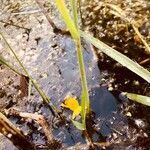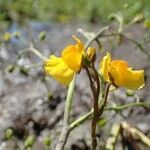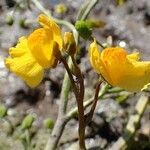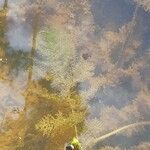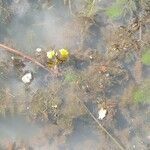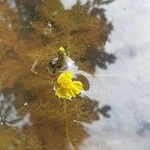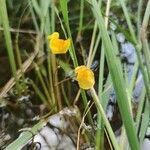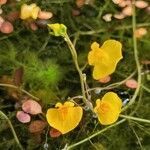Aquatic herb, perennating by winter buds (turions).. Stolons 2 or 3 from the base of the scape, filiform, terete, glabrous, up to 50 cm. long or more, 0.5–1.5 mm. thick; internodes 3–10 mm.; rhizoids few (2–4) from the scape-base, capillary, 1–2 cm. long.. Leaves very numerous, 2-branched from the base, each branch 1–5 cm. long, ovate to lanceolate in outline, pinnately branched; pinnae alternate, repeatedly dichotomously forked; ultimate segments capillary, setulose.. Traps usually numerous, lateral on the leaf-segments just above the point of bifurcation, obliquely ovoid, stalked, 1–2 mm. long; mouth lateral, oblique; upper lip with 2 slender ± branched hairs; lower lip with a variable number of simple hairs.. Inflorescence erect, up to 15 cm. high; scape usually straight at anthesis but becoming very flexuous, 1–2 mm. thick, smooth and glabrous; flowers 4–6, ± congested at anthesis, inflorescence-axis elongating after anthesis; scales 1–2(3), a short distance below the lowermost flower, similar to the bracts; bracts basifixed, orbicular, ± 3 mm. long, decurrent; bracteoles absent; pedicels filiform, 1–2 cm. long, erect at anthesis, elongating and spreading or deflexing after anthesis.. Calyx-lobes subequal, ovate, ± 3 mm. long; upper lobe apex rounded, hyaline; lower lobe truncate or emarginate.. Corolla pale yellow, ±15 mm. long; upper lip orbicular or broadly ovate, truncate, 2–3 times as long as the upper calyx-lobe; lower lip oblate or reniform, ± as long as the upper lip and up to twice as wide; palate raised, gibbous; spur stout, conical, slightly curved, obtuse, usually shorter than the lower lip, with shortly stalked glands on the inner adaxial surface only.. Filaments filiform; anther-thecae confluent.. Ovary globose, minutely lepidote; style distinct, almost as long as the ovary; stigma lower lip semi-orbicular, margin ciliate, upper almost obsolete.. Capsules apparently never produced.
Aquatic. Rhizoids 2—4 near base of peduncle, capillary, 1-2 cm long with a few short botryform segments. Stolons filiform, up to 50 cm long, terete, branched, glabrous. Foliar organs numerous, 1.5-4 cm long, primary segments 2, filiform or sometimes ± inflated, each repeatedly pinnately divided from very near the base into numerous segments, ultimate segments capillary, distinctly flattened, marginally setulose. Globose or ovoid turions (winter buds) 0.5-1.5 cm long of reduced densely setulose foliar segments often present at apex of stolons or stolon branches. Traps usually numerous, lateral on the segments and usually also at the base of the primary segments, obliquely ovoid, 1-2 mm long, shortly stalked, mouth lateral, with simple marginal setae, upper lip with two long branched setiform appendages. Inflorescence erect, up to 40 cm long; peduncle at first straight becoming flexuous post anthesis, relatively stout, 1-2 mm thick terete, glabrous; flowers 4-10, initially congested becoming ± distant; scales 2-3 always present in the upper half of the peduncle, similar to the bracts; bracts basifixed, ± orbicular, 3-5 mm long, base auriculate, apex rounded or obscurely tridentate; bracteoles, absent; pedicels filiform, 1.5-2.5 cm long, erect at anthesis, later ± spreading. Calyx lobes subequal, ovate-oblong, c. 3 mm long, apex of upper rounded, of lower emarginate. Corolla yellow, c. 1 5 mm long, externally glabrous, upper lip ovate to orbicular, 2-3 times as long as upper calyx lobe, lower lip much larger, transversely elliptic, up to 1 6 mm wide, apex rounded or retuse, palate raised, gibbous, spur cylindrical or broadly conical, obtuse, slightly curved, shorter than the lower lip. Filaments linear, curved, anther thecae confluent. Ovary globose, style distinct, about as long as ovary, stigma lower lip semi-orbicular, margin denticulate, upper lip very short. Capsule and seeds not known.
Perennials, suspended aquatic. Rhizoids usually present, filiform, bearing numerous short dichotomously divided branches. Stolons filiform, branched. Traps on leaf segments, stalked, ovoid, 0.5-2.5 mm, mouth lateral or basal; appendages 2, dorsal, simple or branched, setiform, with shorter simple lateral setae. Leaves numerous, 1.5-4 cm, divided from base into 2 ± equal primary segments; primary segment ovate, elliptic, or ovate-oblong in outline, pinnately divided into secondary segments; secondary segments dichotomously divided into further segments; ultimate segments capillary, slightly flattened, margin sparsely denticulate, apex and teeth setulose. Inflorescences erect, (5-)10-30 cm, 3-8-flowered, glabrous; peduncle terete, 1-2 mm thick; scales 1-3, similar to bracts; bracts basifixed, suborbicular, 2-5 mm, base auriculate, apex rounded and obscurely tridentate. Pedicel erect at anthesis but decurved in fruit, terete, 1-2.5 cm; bracteoles absent. Calyx lobes ovate, 3-4 mm, subequal; lower lobe apex emarginate; upper lobe apex rounded. Corolla yellow, 1.2-1.5 cm; lower lip transversely elliptic, base with a prominent swelling, apex rounded to retuse; spur broadly conic, considerably shorter than corolla lower lip, slightly curved, apex obtuse; palate glabrous; upper lip broadly ovate, apex retuse. Filaments ca. 2 mm, curved; anther thecae distinct. Ovary globose, densely covered with sessile glands; style evident; stigma lower lip semicircular and ciliate, upper lip very short or obsolete. Capsule globose, 3-4 mm in diam., circumscissile. Seeds prismatic, 0.5-0.6 × 0.5-0.7 mm, 4-6 angled, narrowly winged on all angles; seed coat with small prominent slightly elongate reticulations. Fl. Jun-Nov, fr. Jul-Dec. 2n = 40, 44.
Glabrous aquatic; stems floating, up to 40 cm or more long, filiform, sparingly branched. Lvs numerous, submerged, multifid, 3-(4) cm long; segments capillary, to ± 1 cm long. Bladders numerous, (1)-2-3-(4) mm long, obliquely ovoid, attached by short stalk to near base of lf segments; mouth usually with 2 long setae. Scape rather stout, to c. 17 cm long, erect, 2-4-(5)-flowered; bracts c. 3 mm long, broad; pedicels to 17 mm long, slender. Calyx lobes oblong to elliptic. Corolla yellow; upper lip 3-lobed; lower entire, 7-9 mm wide, broad; palate protruded; spur short, obtuse. Capsule c. 1.5-2 mm diam., globose.
Corolla pale yellow, more or less 15 mm. long; superior lip circular or broadly ovate, truncate, 2–3 times as long as the upper calyx lobe; inferior lip oblate or reniform, more or less as long as the superior lip and up to twice as wide; palate raised, gibbous; spur stout, conical, slightly curved, obtuse, usually shorteper lip and up to twice as wide; palate raised, gibbous; spur stout, conical, slightly curved, obtuse, usually shorter than the inferior lip, with shortly stalked glands on the whole of the inner surface of the distal half.
Inflorescence erect, up to 15 cm. high; peduncle usually straight at anthesis but becoming very flexuous, 1–2 mm. thick, smooth and glabrous; flowers 4–6, more or less congested at anthesis, inflorescence-axis elongating after anthesis; scales 1–2(3), a short distance below the lowermost flower, similar to the bracts; bracts basifixed, circular, more or less 3 mm. long, decurrent; bracteoles absent; pedicels filiform, 1–2 cm. long, erect at anthesis, elongating and spreading or deflexing after anthesis.
Aquatic herb. Leaves divided into many segments, up to 30 mm long. Flowers: bracteoles 0, bracts basifixed, circular, decurrent; corolla with spur ± as long as lower petal lip, 7-10 mm long, ± densely covered with glandular hairs, yellow, usually with reddish lines on palate. Traps dimorphic, ovoid, 5-25 mm long.
Traps usually numerous, lateral on the leaf-segments just above the point of bifurcation, obliquely ovoid, stalked, 1–2 mm. long; mouth lateral, oblique, with 2 dorsal slender more or less branched hairs, and a variable number of ventral simple hairs.
Leaves very numerous, 2-branched from the base, each branch 1–5 cm. long, ovate to lanceolate in outline, pinnately branched; pinnae alternate, repeatedly dichotomously forked; ultimate segments capillary, setulose.
Stolons 2 or 3 from the base of the peduncle, filiform, terete, glabrous, up to 50 cm. long or more, 0.5–1.5 mm. thick; internodes 3–10 mm; rhizoids few (2–4) from the peduncle base, capillary, 1–12 cm. long.
Ovary globose, minutely lepidote; style distinct, almost as long as the ovary; stigma inferior lip semi-circular, ciliate, superior almost obsolete.
Calyx lobes subequal, ovate, more or less 3 mm. long; superior lobe with apex rounded, hyaline; lower lobe truncate or emarginate.
Aquatic herb, perennating by winter buds (turions).
Filaments filiform; anther-thecae confluent.
Capsules very rarely produced.
